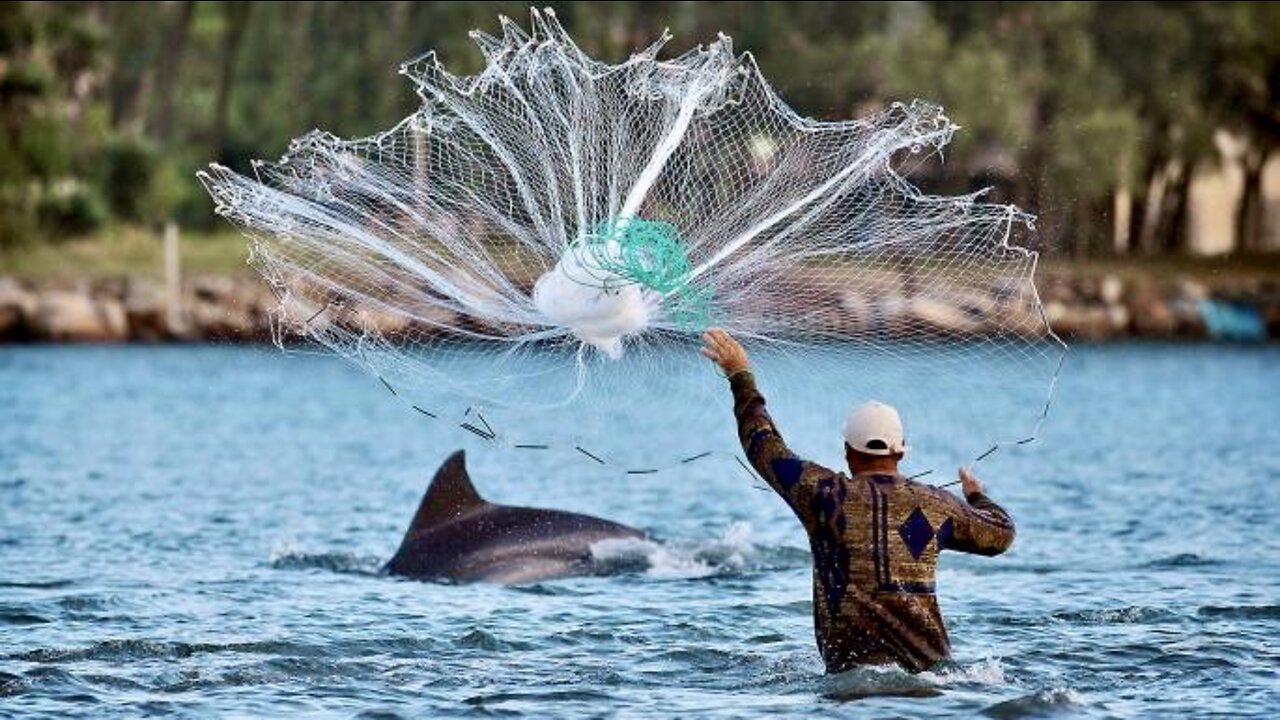Premium Only Content

Wild Dolphins Work with Fishermen to Catch Fish in Brazil
Dolphins and fishermen work together in Laguna, Brazil, to catch groups of mullet. - New research has found that just one local group of about 20 dolphins works with the fishermen, while the other local dolphins don't cooperate, finding other sources of food. The researchers aren't sure what separates these groups.
Scientists had known that dolphins work together to herd groups of mullet, a fish that's an important source of food for local fishermen, toward a line of fishermen in boats or knee-deep water. Then the dolphins signal with specialized head or tail slaps when and where the fishermen should throw their nets. The cooperation is helpful to both parties, researchers said. The two wouldn't survive without each other.
"About 200 local artisanal fishermen are almost entirely reliant on the dolphins for catching their fish," study researcher Fábio Daura-Jorge, of the Federal University of Santa Catarina, in Brazil, wrote in a statement sent to LiveScience. "The fishermen do not fish without the assistance of the dolphins and know the individual animals from their natural marks and can recognize them by eye."
Daura-Jorge added, "The fishermen have names for the cooperative dolphins — particular stars in this cooperation are 'Scooby' and 'Caroba,' that cooperate for more than 15 years."
Cooperative dolphins
The researchers watched the dolphins of Laguna, identifying individuals by their appearance. They documented which animals spent time together, and which ones participated in the fishing. They were able to reconstruct the social structure of 35 of the population's 55 dolphins from this data, which included 15 of the cooperative dolphins.
They identified three distinct social networks within the Laguna dolphins, with one group made up entirely of the fishermen-cooperating dolphins. This cooperation seems to be a learned or inherited behavioral trait, since there's nothing in the environment stopping other dolphins from engaging in it.
"Dolphin societies are very complex, and social interaction seems to drive foraging behavior," Daura-Jorge said. "It might be that the development of specialized foraging behavior occurs in small tight-knit resident coastal communities because there is a high degree of social interaction between the animals."
The technique is profitable for both the local fishermen and the dolphins, which get their share of the catch as well.
The technique is profitable for both the local fishermen and the dolphins, which get their share of the catch as well.
Learning to fish
The cooperation behavior may be passed down from mother dolphin to her calves through social learning. This is how the trait is propagated in the human half of the duo: Elders in the community teach the younger fishermen how to work with the dolphins.
"We are talking about a small subgroup of dolphins ([probably] about 20) supporting over 200 families with no other income," Daura-Jorge said. "The fish provided from the cooperation with dolphins has an important economic and social value that has to be considered," and should be conserved.
"Essentially, if we lose the cooperative dolphins, we lose this unique traditional way of life and vice versa," Daura-Jorge said.
#animals #environment #ecosystem
Music: There She Is by Dhruva Aliman
Amazon- https://amzn.to/3eLFy0P
https://music.apple.com/us/artist/dhruva-aliman/363563637
https://dhruvaaliman.bandcamp.com/album/hello-moon
http://www.dhruvaaliman.com/
Spotify - https://open.spotify.com/artist/5XiFCr9iBKE6Cupltgnlet
-
 49:45
49:45
Knowledge Land
10 months agoFuture War Technology - Armies of Tomorrow
422 -
 1:07:22
1:07:22
barstoolsports
6 hours agoNo One is Safe With Survival at Stake | Surviving Barstool S4 Ep. 2
54.6K3 -
 1:46:50
1:46:50
Laura Loomer
2 hours agoEP90: Biden's Bail Out: Hunter Pardoned By The Big Guy
4.09K9 -
 1:32:19
1:32:19
Fresh and Fit
3 hours agoPamela Anderson Is PROOF That All Women Will HIT The Wall!
23K27 -
 1:14:27
1:14:27
Kim Iversen
5 hours agoVaccine Mandates & Hidden Data: The Truth They Don’t Want You to Hear | Dr. Michael J. Schwartz
15.2K15 -
 1:36:05
1:36:05
Glenn Greenwald
5 hours agoAmericans Rail Against Health Insurance Industry After CEO’s Murder; Syria Expert On New Outbreak Of War | SYSTEM UPDATE #375
85.6K115 -
 6:08:03
6:08:03
Dr Disrespect
11 hours ago🔴LIVE - DR DISRESPECT - SOLO TRIPLE THREAT CHALLENGE
399K285 -
 14:36
14:36
Tundra Tactical
6 hours ago $1.39 earnedNew Jersey AG SUES For FOLLOWING The LAW!!!
15.6K3 -
 55:25
55:25
LFA TV
1 day agoThe COVID Reckoning | Trumpet Daily 12.4.24 7PM EST
58.5K9 -
 1:50:34
1:50:34
2 MIKES LIVE
6 hours ago2 MIKES LIVE #151 w guest Bradley Freedom! United Assasination, Pete Hegseth, Woke SCOTUS and more!
34K1